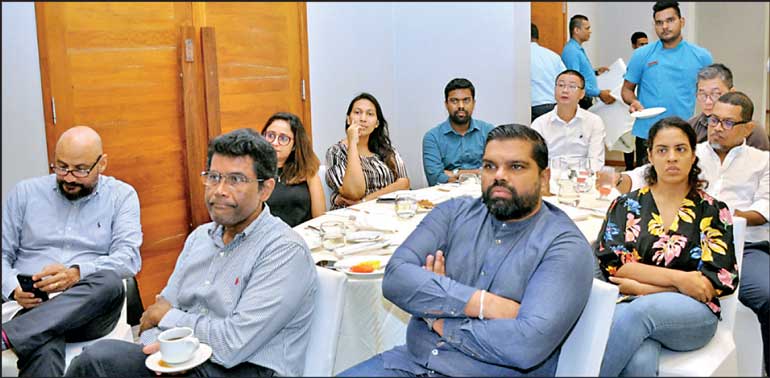Saturday Apr 12, 2025
Saturday Apr 12, 2025
Tuesday, 2 April 2024 00:52 - - {{hitsCtrl.values.hits}}



 By Divya Thotawatte
By Divya Thotawatte
Fabric and Accessories Manufacturers’ Association (FAAMA) recently held an exclusive breakfast meeting where experts predicted turbulent times for the apparel industry, advising businesses to collaborate with superplayers and adapt new marketing strategies.
The meeting, named “State of Fashion 2024 – Pockets of Growth as uncertainty reigns”, featured two speakers from McKinsey and Company; McKinsey and Company Managing Partner Vidhya Ganesan and McKinsey and Company Associate Partner Julian Hügl, who presented the company report on the current state and growth opportunities amidst the uncertainties prevailing with regard to the global apparel industry.
“We are in turbulent times and inflation is something that we have to think about and take care into our decision-making process. The challenges that you see, especially what is going on in different industries and different countries and regions, is something that happens at record level and we see slow economic growth. We had a bounce back effect, especially in your sector after COVID, but we are now at 18 months still in this speculation kind of state, where things don’t really seem to pick up that well.”
The report presented that was made in order to prepare businesses for this future of fashion, looks at three key markets: Europe, the US and China. This is because 80% of the end consumer market is made up of those markets.
The speakers explained that over the last five years, the luxury segment has driven the value creation in the industry, widening a division of luxury and non-luxury within it. Moreover, sports was also an emerging area that would again create a split within the industry with sports and non-sports segments.
During the post-COVID period of time, in 2021, occurred the rebound effect where there was a spike in the luxury segment. The high-end consumers who were unable to travel at the time, spent their money and energy on luxury fashion instead of on travel. For example, China had 40% luxury growth in 2021 while it had reduced significantly in 2022 and 2023, signalling uncertain times for the industry.
Hügl and Ganesan explained that the mid market, which includes brands like H&M and Mango, had also undergone an extremely difficult time in 2021 and 2022. However, the ‘very low’ and ‘price point’ brands have managed to stay resilient while the luxury segment still flourished.
The second half of 2023 has been extremely difficult with flat to negative numbers even though companies were able to create above average shareholders value compared to what they did before COVID. “The positive message that we have for you today is that this industry is still functioning and there is still a very high chance that it’s going to function in the future. We see that this is a highly profitable industry for the shareholders that are involved in this.”
Data also highlighted how while most brands among the industry’s biggest earners still seemed to destroy value, the top 20 players of the industry earned its full economic profit. Over the last two years, 85-100% of the value creation had been done by those top 20 players. While collaboration is still necessary moving forward, it is important to consider these top players of the industry.
“Play with players that have the financial capabilities to keep up with the future, but you don’t always have to work with players who are already super-winners. That’s the other thing to think about, which is, who do you believe you’re betting on as kind of the next super winner? But, even in the losing market, there’s opportunity for someone to walk in and make a win out of it. You can be a winner in every sector if you do that better than everyone else.”
Moreover, in a market that is troubled with oversupply, it is important to focus on the unique selling proposition (USP) that gives your business distinctive advantage whether it is exceptional craftsmanship, new innovative material, sustainability, etc., advised Ganesan.
The report highlighted themes and trends in the industry, where they were divided into three main areas; the global economy, consumer shifts and the fashion system:
The global economy includes a fragmented future where the global economic outlook will continue to be unsettled as financial, geopolitical and other challenges weigh on consumer confidence, affecting the fashion markets where brands may need to bolster contingency planning for uncertainty. Climate urgency is another theme where the industry needs to urgently focus on tackling emissions and building resilience into supply chains.
Consumer shifts highlight how travel will make a comeback in 2024. Consumers are gearing up towards the biggest year of travel since the pandemic, resulting in a reduction of their spend on apparel. But swimwear and leisure wear are industry segments that will benefit. Furthermore, consumers increasingly trust influencers more than marketing messages of brands. Brands will have to strategise and market accordingly.
Fashion system includes Generative AI which has recently boomed and has democratised creativity. Creating value will require brands to explore Gen AI’s potential to enhance the work of human creatives. Another area to consider is fast fashion where companies are bringing new tactics on price, customer experience, speed and manufacturing capabilities, which could be increasingly attractive to key fashion players. Brand marketing and forging emotional connections with consumers will be necessary. Sustainability will also be a key theme in 2024.
The apparel industry could therefore still be cautiously optimistic while considering the risks; while inflation was the primary risk in 2023, geopolitical instability and conflicts followed by inflation will be the biggest risks this year. 2024 will not be the year that the apparel industry could escape the uncertainty of its future, not yet, said the experts.
Therefore, being strategic and doing more marketing sensing, geopolitical sensing, etc. during the decision-making processes is crucial. Getting ahead of the cost-competitiveness by getting close to the world-class benchmark standards, building a portfolio of collaborations with super-winners, a focus on the business USPs, etc. will be beneficial.
Pix by Lasantha Kumara
Discover Kapruka, the leading online shopping platform in Sri Lanka, where you can conveniently send Gifts and Flowers to your loved ones for any event including Valentine ’s Day. Explore a wide range of popular Shopping Categories on Kapruka, including Toys, Groceries, Electronics, Birthday Cakes, Fruits, Chocolates, Flower Bouquets, Clothing, Watches, Lingerie, Gift Sets and Jewellery. Also if you’re interested in selling with Kapruka, Partner Central by Kapruka is the best solution to start with. Moreover, through Kapruka Global Shop, you can also enjoy the convenience of purchasing products from renowned platforms like Amazon and eBay and have them delivered to Sri Lanka.
Discover Kapruka, the leading online shopping platform in Sri Lanka, where you can conveniently send Gifts and Flowers to your loved ones for any event including Valentine ’s Day. Explore a wide range of popular Shopping Categories on Kapruka, including Toys, Groceries, Electronics, Birthday Cakes, Fruits, Chocolates, Flower Bouquets, Clothing, Watches, Lingerie, Gift Sets and Jewellery. Also if you’re interested in selling with Kapruka, Partner Central by Kapruka is the best solution to start with. Moreover, through Kapruka Global Shop, you can also enjoy the convenience of purchasing products from renowned platforms like Amazon and eBay and have them delivered to Sri Lanka.